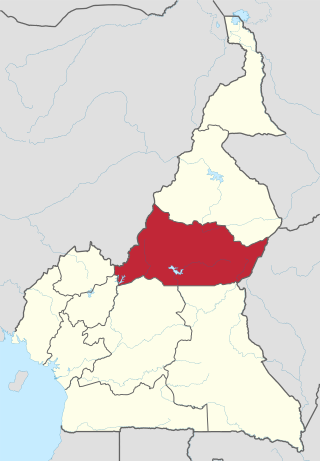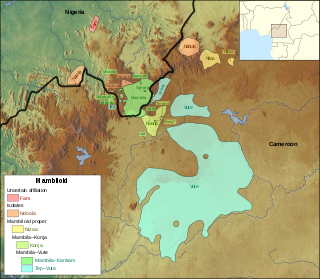Related Research Articles
The Bung language is a nearly extinct, endangered language of Cameroon spoken by three people at the village of Boung on the Adamawa Plateau. It is remembered best by one speaker who learned the language at a young age, though it is not his mother tongue. A wordlist shows its strongest resemblance to be with the Ndung dialect of Mambiloid language Kwanja, although that may simply be because this has become the dominant language of the village where Bung's last speakers reside. It also has words in common with other Mambiloid languages such as Tep, Somyev and Vute, while a number of words' origins remain unclear. For lack of data, it is not definitively classified.

The Adamawa Region is a constituent region of the Republic of Cameroon. It borders the Centre and East regions to the south, the Northwest and West regions to the southwest, Nigeria to the west, the Central African Republic (CAR) to the east, and the North Region to the north.
The Yeni language is an extinct language of Cameroon, formerly spoken around Djeni Mountain in the Nyalang area. All that remains of the language, apparently, is a song remembered by some Sandani speakers. However, according to Bruce Connell, comparison of the song's words to neighboring languages suggests that "it was closely related to [the Mambiloid languages] Cambap, Njerep, and Kasabe."
Sardauna Local Government Area is located in the extreme southeast of Taraba State in Nigeria. It sits atop the Mambilla Plateau, which is dotted by other towns such as Maisamari and Nguroje. The capital of the LGA is Gembu, which is the principal town of various ethnic groups, such as Mambilla, Kaka, Fulani, Ndola, Tigon, Kambu, Chamba and Panso. Other ethnic groups from the mainstream Nigeria and the bordering Cameroon republic such as Hausa and Kanuri also live there.

Cameroon is home to at least 250 languages. However, some accounts report around 600 languages. These include 55 Afro-Asiatic languages, two Nilo-Saharan languages, four Ubangian languages, and 169 Niger–Congo languages. This latter group comprises one Senegambian language (Fulfulde), 28 Adamawa languages, and 142 Benue–Congo languages . French and English are official languages, a heritage of Cameroon's colonial past as a colony of both France and the United Kingdom from 1916 to 1961. Eight out of the ten regions of Cameroon are primarily francophone, representing 83% of the country's population, and two are anglophone, representing 17%. The anglophone proportion of the country is in constant regression, having decreased from 21% in 1976 to 20% in 1987 and to 17% in 2005, and is estimated at 16% in 2015.
The Mambilla or Mambila people of Nigeria live on the Mambilla Plateau. A small fraction of Mambilla migrants left the Mambilla Plateau for the Ndom Plain on the Cameroon side of the international border as well as in a couple of small villages, such as New Namba, on the Gashaka Plain in the north, and Jiini-Nyalang-Langa area close to the Kwanja. Today, the preferred ethnonym is spelt Mambila in Cameroon and Mambilla in Nigeria. "Norr" is also used.

The twelve Mambiloid languages are languages spoken by the Mambila and related peoples mostly in eastern Nigeria and in Cameroon. In Nigeria the largest group is Mambila. In Cameroon the largest group is Vute.
The Nimbari language, which is no longer spoken, was a member of the Leko–Nimbari group of Savanna languages. It was spoken in northern Cameroon. Ethnologue lists Badjire, Gorimbari, and Padjara-Djabi villages as Nimbari locations in Bénoué and Mayo-Louti divisions.
Wawa is a Mambiloid language spoken in a region of Cameroon and just inside bordering Nigeria used by about 3,000 people in three main dialects.

The Mambilla Plateau is a plateau in the Taraba State of Nigeria. The Mambilla Plateau has an average elevation of about 1,600 metres (5,249 ft) above sea level, making it the highest plateau in Nigeria. Some of its villages are situated on hills that are at least 1,828 metres (5,997 ft) above sea level. Some mountains on the plateau and around it are over 2,000 metres (6,562 ft) high, like Gang or Chappal Waddi which has a height of 2,419 metres (7,936 ft) above sea level. It is the highest mountain in Nigeria and in West Africa. The Mambilla Plateau measures about 96 km (60 mi) along its curved length; it is 40 km (25 mi) wide and is bounded by an escarpment that is about 900 m (2,953 ft) high in some places. The plateau covers an area of over 9,389 square kilometres (3,625 sq mi).
Mambila is a dialect chain stretching across Nigeria and Cameroon. It is one of the Mambiloid languages, a branch of Benue–Congo.
Ndoola (Ndoro) or Njoyamɛ in Cameroon is a Bantoid language of Nigeria, with several thousand speakers in Cameroon. It is either among or related to the Mambiloid languages.
Mbongno (Bungnu), also known as Kamkam, is a Mambiloid language of Nigeria, with an unknown number of speakers in Cameroon.
Somyev (Somyewe), also known as Kila, is a nearly extinct Mambiloid language of two villages, one in Nigeria and one in Cameroon, that is spoken by a caste of blacksmiths that live among the Mambila. Although the language is still used for daily communication, the youngest generation of speakers were born in the 1950s. Transmission of the language ceased when the profession of blacksmithing lost its social status, partly due to imports of foreign tools.
Tep is a Mambiloid language of Nigeria. Ethnologue considers it a dialect of Mambila, as speakers identify as Mambila, but it is a distinct language.
Mvanip (Mvano), or Magu, is a minor Mambiloid language of Nigeria. Despite the small number of speakers, language use is vigorous. Ethnologue classifies Mvanip as threatened.
Njerep (Njerup) is a Mambiloid language spoken in the Adamawa Region of Cameroon. Njerep is essentially extinct, with only 4 people who speak it at home. Though word lists and grammatical information have been collected from these people, the information remains fragmented.
The Kasabe language is an extinct language of Cameroon, formerly spoken around Mambila in the Nyalang area. The last speaker, a man named Bogon died on 5 November 1995.
Ndola People are found in Taraba, Nigeria and located in Kurmi and Ngada. Few are also found in Cameroon.
Northern Bantoid is a branch of the Bantoid languages. It consists of the Mambiloid, Dakoid, and Tikar languages of eastern Nigeria and west-central Cameroon.